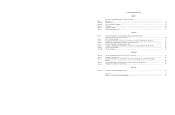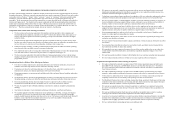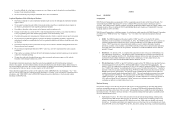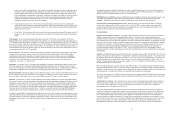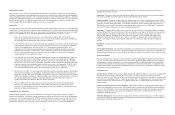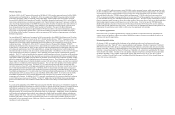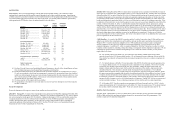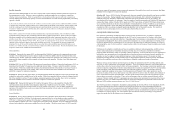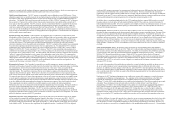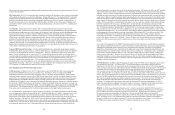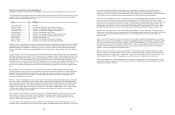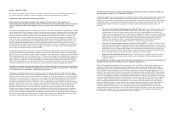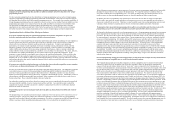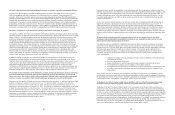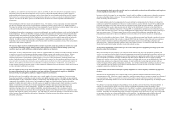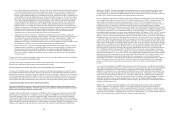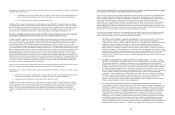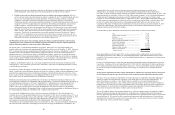Dish Network 2012 Annual Report Download - page 14
Download and view the complete annual report
Please find page 14 of the 2012 Dish Network annual report below. You can navigate through the pages in the report by either clicking on the pages listed below, or by using the keyword search tool below to find specific information within the annual report.16
16
failure to access such programming could materially and adversely affect our ability to compete in regions serviced
by these cable providers.
MDU Exclusivity. The FCC has found that cable companies should not be permitted to have exclusive relationships
with multiple dwelling units (e.g., apartment buildings). In May 2009, the D.C. Circuit upheld the FCC’s decision.
While the FCC requested comments in November 2007 on whether DBS and Private Cable Operators should be
prohibited from having similar relationships with multiple dwelling units, it has yet to make a formal decision. If
the cable exclusivity ban were to be extended to DBS providers, our ability to serve these types of buildings and
communities would be adversely affected. We cannot predict the timing or outcome of the FCC’s consideration of
this proposal.
Net Neutrality. During 2010, the FCC imposed rules of nondiscrimination and transparency upon wireline
broadband providers. While this decision provides certain protection from discrimination by wireline broadband
providers against our distribution of video content via the Internet, it may still permit wireline broadband providers
to provide certain services over their wireline broadband network that are not subject to these requirements.
Although the FCC imposed similar transparency requirements on wireless broadband providers, which includes 2
GHz licenses, it declined to impose a nondiscrimination rule. Instead, wireless broadband Internet providers are
prohibited from blocking websites and applications that compete with voice and video telephony services. The
FCC’s net neutrality rules have been challenged in Federal court and could be curtailed or overturned if those
challenges are successful. It is uncertain how these requirements, even if they are affirmed by the Federal court of
appeals, may be interpreted and enforced by the FCC; therefore, we cannot predict the practical effect of these rules
on our ability to distribute our video content via the Internet.
Comcast-NBCUniversal Transaction. Comcast and General Electric have joined their programming properties,
including NBC, Bravo and many others, in a venture, NBCUniversal, controlled by Comcast, which was approved
by the FCC and the Department of Justice in January 2011. The FCC conditioned its approval on, among other
things, Comcast complying with the terms of the FCC’s recent order on network neutrality (even if that order is
vacated by judicial or legislative action) and Comcast licensing its affiliated content to us, other traditional pay-TV
providers and certain providers of video services over the Internet on fair and nondiscriminatory terms and
conditions, including, among others, price. If Comcast does not license its affiliated content to us on fair and
nondiscriminatory terms and conditions, we can seek binding arbitration and continue to carry such content while
the arbitration is pending. However, it is uncertain how these conditions may be interpreted and enforced by the
FCC; therefore, we cannot predict the practical effect of these conditions.
FCC Regulation of our Wireless Spectrum Licenses
2 GHz Spectrum. On March 2, 2012, the FCC approved the transfer of 40 MHz of 2 GHz wireless spectrum
licenses held by DBSD North America and TerreStar to us. On March 9, 2012, we completed the DBSD
Transaction and the TerreStar Transaction, pursuant to which we acquired, among other things, certain satellite
assets and wireless spectrum licenses held by DBSD North America and TerreStar. In addition, during the fourth
quarter 2011, we and Sprint entered into the Sprint Settlement Agreement pursuant to which all issues then being
disputed relating to the DBSD Transaction and the TerreStar Transaction were resolved between us and Sprint,
including, but not limited to, issues relating to costs allegedly incurred by Sprint to relocate users from the spectrum
then licensed to DBSD North America and TerreStar. Pursuant to the Sprint Settlement Agreement, we made a net
payment of approximately $114 million to Sprint. The total consideration to acquire these assets was approximately
$2.860 billion. This amount includes $1.364 billion for the DBSD Transaction, $1.382 billion for the TerreStar
Transaction, and the net payment of $114 million to Sprint pursuant to the Sprint Settlement Agreement.
Our consolidated FCC applications for approval of the license transfers from DBSD North America and TerreStar
were accompanied by requests for waiver of the FCC’s Mobile Satellite Service (“MSS”) “integrated service” and
spare satellite requirements and various technical provisions. The FCC denied our requests for waiver of the
integrated service and spare satellite requirements but did not initially act on our request for waiver of the various
technical provisions. On March 21, 2012, the FCC released a Notice of Proposed Rule Making (“NPRM”)
proposing the elimination of the integrated service, spare satellite and various technical requirements attached to the
2 GHz licenses. On December 11, 2012, the FCC approved rules that eliminated these requirements and gave notice
of its proposed modification of our 2 GHz authorizations to, among other things, allow us to offer single-mode
17
17
terrestrial terminals to customers who do not desire satellite functionality. On February 15, 2013, the FCC issued an
order, which will become effective on March 7, 2013, modifying our 2 GHz licenses to add terrestrial operating
authority. The FCC’s order of modification has imposed certain limitations on the use of a portion of this spectrum,
including interference protections for other spectrum users and power and emission limits that we presently believe
could render 5 MHz of our uplink spectrum effectively unusable for terrestrial services and limit our ability to fully
utilize the remaining 15 MHz of our uplink spectrum for terrestrial services. These limitations could, among other
things, impact the finalization of technical standards associated with our wireless business, and may have a material
adverse effect on our ability to commercialize these licenses. The new rules also mandate certain interim and final
build-out requirements for the licenses. By March 2017, we must provide terrestrial signal coverage and offer
terrestrial service to at least 40% of the aggregate population represented by all of the areas covered by the licenses
(the “2 GHz Interim Build-out Requirement”). By March 2020, we must provide terrestrial signal coverage and
offer terrestrial service to at least 70% of the population in each area covered by an individual license (the “2 GHz
Final Build-out Requirement”). If we fail to meet the 2 GHz Interim Build-out Requirement, the 2 GHz Final Build-
out Requirement will be accelerated by one year, from March 2020 to March 2019. If we fail to meet the 2 GHz
Final Build-out Requirement, our terrestrial authorization for each license area in which we fail to meet the
requirement will terminate. In addition, the FCC is currently considering rules for a spectrum band that is adjacent
to our 2 GHz licenses, known as the “H Block.” If the FCC adopts rules for the H block that do not adequately
protect our 2 GHz licenses, there could be a material adverse effect on our ability to commercialize the 2 GHz
licenses.
As a result of the completion of the DBSD Transaction and the TerreStar Transaction, we will likely be required to
make significant additional investments or partner with others to, among other things, finance the commercialization
and build-out requirements of these licenses and our integration efforts including compliance with regulations
applicable to the acquired licenses. Depending on the nature and scope of such commercialization, build-out, and
integration efforts, any such investment or partnership could vary significantly. Additionally, recent consolidation
in the wireless telecommunications industry, may, among other things, limit our available options, including our
ability to partner with others. There can be no assurance that we will be able to develop and implement a business
model that will realize a return on these spectrum licenses or that we will be able to profitably deploy the assets
represented by these spectrum licenses, which may affect the carrying value of these assets and our future financial
condition or results of operations.
700 MHz Spectrum. In 2008, we paid $712 million to acquire certain 700 MHz wireless spectrum licenses, which
were granted to us by the FCC in February 2009. These licenses mandate certain interim and final build-out
requirements. By June 2013, we must provide signal coverage and offer service to at least 35% of the geographic
area in each area covered by each individual license (the “700 MHz Interim Build-out Requirement”). By the end of
our license term (June 2019), we must provide signal coverage and offer service to at least 70% of the geographic
area in each area covered by each individual license (the “700 MHz Final Build-out Requirement”). We have
recently notified the FCC of our plans to commence signal coverage in select cities within certain of these areas, but
we have not yet developed plans for providing signal coverage and offering service in all of these areas. If we fail to
meet the 700 MHz Interim Build-out Requirement, the term of our licenses will be reduced, from June 2019 to June
2017, and we could face possible fines and the reduction of license area(s). If we fail to meet the 700 MHz Final
Build-out Requirement, our authorization for each license area in which we fail to meet the requirement will
terminate. To commercialize these licenses and satisfy the associated FCC build-out requirements, we will be
required to make significant additional investments or partner with others. Depending on the nature and scope of
such commercialization and build-out, any such investment or partnership could vary significantly.
MVDDS. In 2010, we purchased all of South.com L.L.C., which is an entity that holds MVDDS licenses in 37
markets in the United States. In October 2012, we agreed to purchase additional MVDDS licenses in 45 markets
from an affiliate of Cablevision Systems Corporation (“Cablevision”). We have agreed to lease four of these
licenses to a wholly-owned subsidiary of Cablevision. We now have MVDDS licenses in 82 out of 214
geographical license areas, including Los Angeles, New York City, Chicago and several other major metropolitan
areas. By August 2014, we are required to meet certain FCC build-out requirements related to our MVDDS
licenses. In addition, we are subject to certain FCC service rules applicable to these licenses. Part or all of our
MVDDS licenses may be terminated if these FCC build-out requirements are not satisfied.


